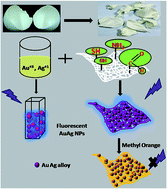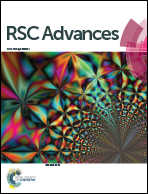Water soluble blue-emitting AuAg alloy nanoparticles and fluorescent solid platforms for removal of dyes from water†
Abstract
Chicken egg shell membrane, a naturally abundant protein membrane, was used to synthesize gold (Au), silver (Ag) and their bimetallic (AuAg) alloy nanoclusters at room temperature without the use of any reducing agent or catalyst. The as-formed gold and alloy clusters were highly fluorescent and exhibited intense blue emission around 435 ± 5 and 440 ± 5 nm, respectively. This is the first report confirming the formation of fluorescent alloy clusters exhibiting nanosecond lifetimes by a biomembrane-induced reduction process. We have also explored the capability of these metal cluster immobilized inexpensive ESMs in removing organic dyes from water. The results confirmed that it is the strong adsorption of the dye molecules in the presence of the metal particles that has helped to convert ESM into an effective platform for water purification. This process has the dual advantages of utilizing an inexpensive, abundant and eco-friendly food waste (egg shell membrane) for in situ reduction and formation of metal nanoparticles and the utilization of the same as an effective platform for the removal of anionic dyes from waste water. An Au-immobilized ESM showed a better efficiency in dye molecules removal than those of the Ag-ESM and AuAg-ESM membranes.


 Please wait while we load your content...
Please wait while we load your content...